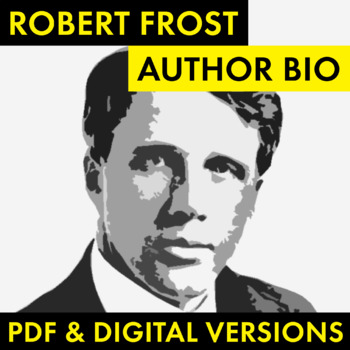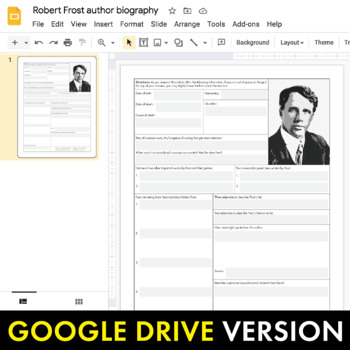Robert Frost Author Study Worksheet, Frost Biography, PDF & Google Drive, CCSS
- PDF
- Google Apps™

What educators are saying
Description
Skip the typical Robert Frost introduction lecture as you launch a study of any of his works and, instead, empower students to find their own interesting facts about this author’s life with this “Author Bio” print/post-and-teach activity.
This single-page worksheet (includes printable PDF and Google Drive versions) is a powerful research organizer that’ll get students digging deep into Frost’s background.
Here are a few suggested uses for this flexible research tool:
1. Book your school’s computer lab or have students access Robert Frost’s biography information on their own devices. Assign students to either work solo or in teams of two. Once the grids are complete, have students share and compare answers in small groups, focusing on the four interesting facts they discovered, the meaningful quote, and the personal/professional obstacle. Then, pull the students into a full-class discussion, having each group present an interesting fact, quote, or obstacle until every team has contributed. No repeats allowed.
This assignment works great as an “into” activity, but it could also be a “through” activity to add variety to your in-class routine as you work through a longer work. If you’re using this as an “after” activity, during the discussion I would also ask how any of the biography elements are reflected in the author’s work/s the class just studied.
2. Assign the worksheet as a traditional homework assignment. Launch the discussion mentioned in #1 at the beginning of the next class period.
3. Use the grid as the beginning assignment to a larger project where students must read two or three pieces by Robert Frost. Later, this author study could be turned into a compare/contrast essay or a speech presentation, if you wish to expand the assignment. (Author Bio sheets on a variety of different writers are available in my shop if you want to vary speech topics within one class.)
4. Use as an emergency sub plan.
I hope you and your students enjoy this activity! If you need an Author Bio worksheet for any author not currently offered in my shop, please send a message to me through the “Ask a Question” tab and I’ll do my best to quickly make that happen.
Thanks for stopping by!
(Please note: This item is not included in any of my other materials. Also, the image on the student PDF worksheet is slightly ghosted to save printer/copier ink. I encourage students to doodle/shade in that space as they work.)
Image credit: WikiMedia Commons, Public domain




